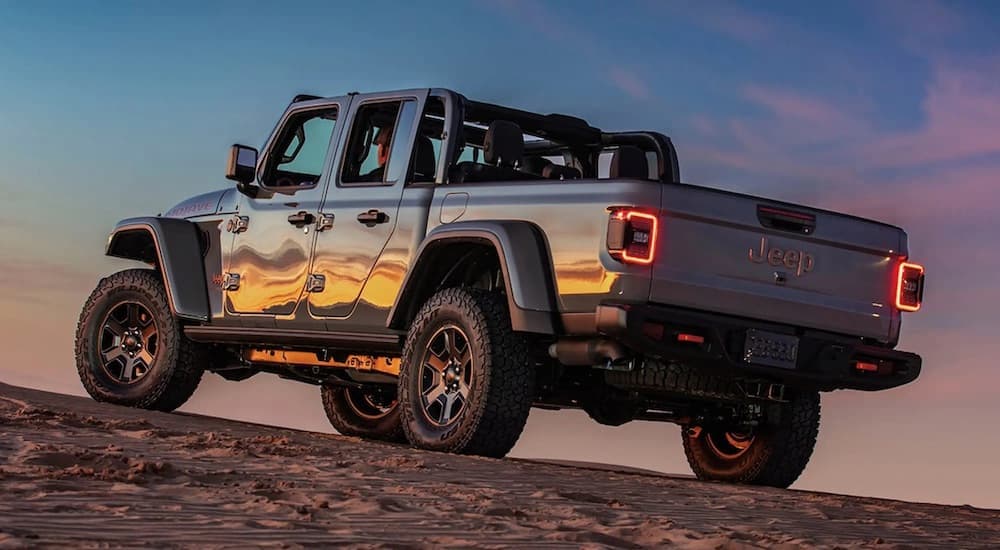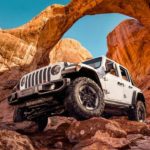Jeeps are made to take on anything, especially the Wrangler and Gladiator. Since the Jeep brand became popular among civilians in the 1940s, it’s largely been associated with literally driving over the river and through the woods.
Back in the 1980s, the Jeep Scrambler CJ-8 was an elongated version of the popular Jeep CJ-7, with a pickup truck bed instead of a rear passenger area. The Scrambler disappeared when the Jeep CJ gave way to the Wrangler that replaced it, with no pickup version available for many years. Jeep enthusiasts never forgot about the Scrambler, though, and always wondered if we would get a Wrangler-based pickup someday. That dream came true for the 2020 model year when the modern Gladiator first appeared at your local Jeep dealer.
Why would someone choose one over the other? There are obvious reasons, like the fact that the Gladiator is a pickup truck with a bed and the Wrangler is not. When playing a game of Would You Rather with these two off-road vehicles, though, there are many other factors to consider.
Which Has Been Doing It Longer?
For some drivers, having a vehicle purposefully designed for off-roading is important, but it might surprise you to know that the Wrangler is a surprisingly recent addition to the Jeep lineup. If someone were to choose their Jeep based on brand longevity alone, the Gladiator would be the winner.
The original Gladiator was an introduction for the 1963 model year. Even then, the Gladiator came equipped with a serious Dana transfer case, along with independent front suspension and a hulking front differential to provide drivers with the solid ride they needed.
The name “Gladiator” disappeared in the early 1970s, and the CJ-based Scrambler pickup truck ceased production in 1987. But luck was on the Gladiator’s side, and the name was revived for the 2020 model year, in full force and ready to rock.
While 1987 was a sad year for the old Scrambler, it was a good year for Wrangler. That’s when the traditional Jeep CJ was replaced by this new take on the original Willys-Overland military four-wheel-drive vehicle. Originally, the Wrangler was supposed to be a more on-road-oriented Jeep, but that quickly changed to remain true to its off-road roots..
From the YJ to the TJ to the JK and today’s JL model we’ve enjoyed since 2018, the Wrangler has evolved into a slightly different beast with each generation, incorporating the latest off-roading technology and needs. Historically speaking, the Gladiator has plenty of years of experience behind it, but it could be argued that the constantly evolving Wrangler has delivered exactly what drivers want over many generations, making it constantly relevant. It’s a tough choice and depends on where you draw the line between old and new.!
Which Does Off-Roading Better Today?
History is interesting, but what’s most important to the modern driver is which of these is the better performer off-road today. To answer that question most accurately, you would have to have the same driver take the same version of the Wrangler and the Gladiator over the same trail with absolutely no changes.
Wranglers are offered in seven trims for 2024: the Sport, Sport S, Willys, Sahara, Rubicon, Rubicon X, and Rubicon 392. While each model is equipped and ready to excel at outdoor sports, climbing through the trim levels unlocks a few extra goodies to make a driving adventure more enjoyable. For example, the Willys model includes bigger tires, higher ground clearance, a rear locking differential, and rock rails. The Rubicon trim includes a Dana 44 heavy-duty full-float solid rear axle, a steel front bumper, and a WARN winch rated up to 8,000 lbs for recovery efforts.
There are also seven potential Gladiator options in 2024: Sport, Sport S, Willys, Mojave, Mojave X, Rubicon, and Rubicon X. Every Gladiator is equipped with equipment that brings no doubt to each trim’s Trail Rated or Desert Rated badge. From the same Dana 44 heavy-duty front and rear axles that have been on board since the beginning, to skid plates and tow hooks, to features like a two-speed transfer case and traction control, all Gladiators are ready to crush the trail.
While all capable, the Willys model adds features like an Off-Road+ driving mode. The Mojave adds Fox 2.5-inch internal bypass shocks with reservoirs and Fox front hydro jounce bumpers, which are joined by an integrated front-facing off-road camera and Selec-Trac full-time transfer case. While “best” is a hard thing to declare, it is very clear that drivers who scour the spec lists of both the Wrangler and the Gladiator will have plenty of options to boost their off-road performance.
Which Is Cooler?
Both the Wrangler and Gladiator have two- and four-door options, along with removable hard and soft top options and removable doors. They both include a windshield-integrated stealth antenna and offer access to Jeep Adventure Guides through the infotainment system with Trails Offroad, loaded with comprehensive off-road trail guides for the 62 Jeep Badge of Honor trails. However, there are a few special features exclusive to each model.
For example, Wrangler drivers can add the Xtreme 35 Package to all trims except the Rubicon 392. This package includes 35-inch tires that give the Wrangler an impressive 12.9-inch ground clearance with 34-inch water fording depth. It also upgrades the approach and departure angles to 47.4° and 40.4°, respectively. You can’t add this package to the Rubicon 392 trim because it includes it as standard equipment. The Wrangler Rubicon 392 goes hardcore with an exclusive 6.4L HEMI V8 engine that takes everything in stride, with 470 hp and 470 lb-ft of torque.
On the Gladiator side, two new trims have joined the lineup. The Mojave X and Rubicon X add features like a full-time transfer case, integrated off-road camera, and front and rear steel bumpers to a list of equipment that includes Dana 44 axles, Tru-Lok axle lockers, and specialty transfer cases with their own distinct gear ratios. The Gladiator Willys trim has also received updates, including a Tru-Lok rear-axle locker and an Off-Road+ drive mode that can lock the rear axle in high gear.
The biggest difference between the Wrangler and Gladiator’s “cool factors” is the choice of engines. Both offer the same base 3.6L Pentastar V6, which makes 280 hp and 260 lb-ft of torque. (This is also the only engine that can be paired with a six-speed manual transmission rather than the standard eight-speed automatic.) The 3.0L EcoDiesel V6, making 260 hp and 422 lb-ft of torque, is also available in both models.
For the Gladiator, that’s it, while the Wrangler offers four additional powertrains not available in the Gladiator. The Wrangler offers an eTorque mild hybrid version of the 3.6L Pentastar V6. Also available is a 2.0L Turbo I-4, making 270 hp and 295 lb-ft of torque. These figures are similar to the V6, but provide slightly better fuel economy. A partial hybrid version of this engine is also available, bumping performance numbers to 375 hp and 470 lb-ft. Finally, the previously mentioned Rubicon 392 unlocks the 6.4L HEMI 392 Apache V8, with its 470 hp and 470 lb-ft of torque. This is probably the “coolest” engine of any of these options.
Team Wrangler or Team Gladiator?
Regardless of your level of experience or preferred trail surface, Jeep has provided solid, confident off-road vehicles that have earned their Trail Rated and Desert Rated badges through thoughtful engineering, with mechanical features and technology that have the potential to allow you to explore new frontiers. Whether your preferences gravitate towards the Wrangler or the Gladiator, you’re bound to find the start of a fantastic adventure behind the wheel of a Jeep.




